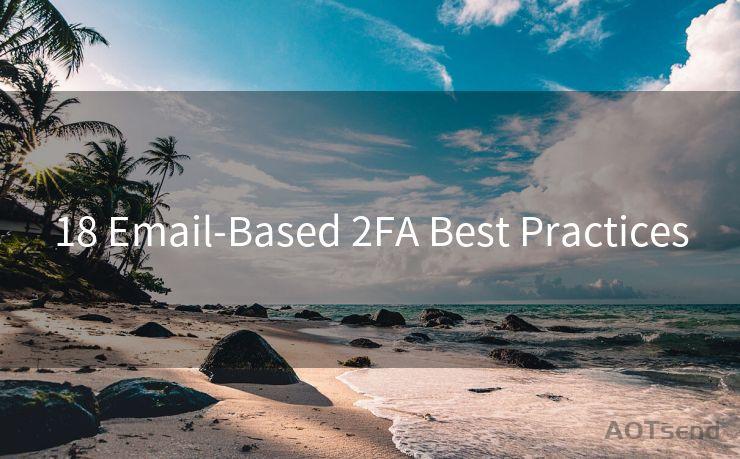18 Email-Based 2FA Best Practices




In the digital age, security is paramount, and two-factor authentication (2FA) has become a crucial component of online security. Among various 2FA methods, email-based 2FA stands out as a popular and convenient option. In this blog, we'll explore 18 best practices for implementing email-based 2FA to ensure robust and secure authentication.
1. Use Strong and Unique Passwords
The first line of defense is a strong and unique password for your email account. Avoid using common passwords or patterns that can be easily guessed or brute-forced.
2. Enable HTTPS for Email Access
Always access your email via a secure HTTPS connection. This ensures that your login credentials and 2FA codes are transmitted securely.
3. Verify Email Sender
Before clicking on any links or opening attachments in emails claiming to be from a service you use, verify the sender's email address. Phishing attacks often mimic legitimate services to steal your information.
4. Don't Click Suspicious Links
Never click on links in emails that seem suspicious or unexpected, even if they appear to come from a trusted source. These could be phishing attempts to steal your 2FA codes.
5. Use Dedicated Email for 2FA
Consider using a separate, dedicated email account for 2FA purposes. This reduces the risk of your primary email being compromised and affecting your 2FA security.
6. Regularly Update and Patch Email Clients
Keep your email clients and systems up to date with the latest security patches. This helps protect against known vulnerabilities that could be exploited by attackers.
7. Implement DMARC, DKIM, and SPF
These email authentication protocols help verify the legitimacy of emails claiming to be from your domain, reducing the risk of spoofing and phishing attacks.
🔔🔔🔔
【AOTsend Email API】:AOTsend is a Managed Email Service for sending transactional emails. Support Email Types: reminders, authentication, confirmations, notifications, verification codes, invoices, password resets, account activations, billing statements, two-factor authentication (2FA), and one-time passwords (OTP) emails, etc. $0.28 per 1000 Emails. 99% Delivery, 98% Inbox Rate.
You might be interested in:
Why did we start the AOTsend project, Brand Story?
What is a Managed Email API, How it Works?
Best 25+ Email Marketing Platforms (Authority,Keywords&Traffic Comparison)
Best 24+ Email Marketing Service (Price, Pros&Cons Comparison)
Email APIs vs SMTP: How they Works, Any Difference?
8. Monitor and Respond to Suspicious Activity
Regularly monitor your email account for any suspicious activity, such as unexpected login attempts or changes to your account settings.
9. Use a Trusted Email Provider
Choose a reputable email provider with a proven track record in security. This adds another layer of protection to your email-based 2FA system.
10. Educate Users on Email Security
Regularly educate users on email security best practices, including recognizing and avoiding phishing attacks, creating strong passwords, and using 2FA.
11. Limit Access to Email Accounts
Restrict access to email accounts used for 2FA to authorized personnel only. Avoid sharing these accounts with unnecessary individuals.
12. Implement Account Lockout Policies
Set account lockout policies to prevent brute-force attacks on email accounts used for 2FA. This limits the number of failed login attempts allowed before the account is temporarily locked.
13. Consider Additional Security Measures
Explore additional security measures, such as using a virtual private network (VPN) when accessing email accounts from public networks.
14. Backup and Recovery Plan
Have a backup and recovery plan in place for your email accounts. This ensures that you can quickly restore access in case of any unexpected issues.
15. Regular Security Audits
Conduct regular security audits to identify and address any potential vulnerabilities in your email-based 2FA system.
16. Multi-Factor Authentication
Consider implementing multi-factor authentication (MFA) for critical email accounts. This adds an extra layer of security beyond just 2FA.
17. Avoid Using Public Computers for 2FA
Avoid using public computers or unsecured networks to access email accounts used for 2FA. These environments are more prone to keylogging and other security risks.
18. Stay Vigilant
Stay vigilant and keep yourself updated on the latest email and 2FA security threats. This helps you stay ahead of potential attacks and protect your accounts accordingly.

By following these 18 best practices for email-based 2FA, you can significantly enhance the security of your online accounts and protect yourself from potential threats. Remember, security is an ongoing process, and staying vigilant is key to maintaining a secure online presence.




Scan the QR code to access on your mobile device.
Copyright notice: This article is published by AotSend. Reproduction requires attribution.
Article Link:https://www.mailwot.com/p2156.html



